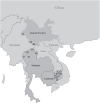An updated phylogeny of the human Y-chromosome lineage O2a-M95 with novel SNPs
- PMID: 24972021
- PMCID: PMC4074153
- DOI: 10.1371/journal.pone.0101020
An updated phylogeny of the human Y-chromosome lineage O2a-M95 with novel SNPs
Abstract
Though the Y-chromosome O2a-M95 lineage is one of the major haplogroups present in eastern Asian populations, especially among Austro-Asiatic speaking populations from Southwestern China and mainland Southeast Asia, to date its phylogeny lacks structure due to only one downstream SNP marker (M88) assigned to the lineage. A recent array-capture-based Y chromosome sequencing of Asian samples has yielded a variety of novel SNPs purportedly belonging to the O2a-M95 lineage, but their phylogenetic positions have yet to be determined. In this study, we sampled 646 unrelated males from 22 Austro-Asiatic speaking populations from Cambodia, Thailand and Southwestern China, and genotyped 12 SNP makers among the sampled populations, including 10 of the newly reported markers. Among the 646 males, 343 belonged to the O2a-M95 lineage, confirming the supposed dominance of this Y chromosome lineage in Austro-Asiatic speaking populations. We further characterized the phylogeny of O2a-M95 by defining 5 sub-branches: O2a1*-M95, O2a1a-F789, O2a1b*-F1252, O2a1b1*-M88 and O2a1b1a -F761. This updated phylogeny not only improves the resolution of this lineage, but also allows for greater tracing of the prehistory of human populations in eastern Asia and the Pacific, which may yield novel insights into the patterns of language diversification and population movement in these regions.
Conflict of interest statement
Figures
Similar articles
-
Y-chromosome diversity suggests southern origin and Paleolithic backwave migration of Austro-Asiatic speakers from eastern Asia to the Indian subcontinent.Sci Rep. 2015 Oct 20;5:15486. doi: 10.1038/srep15486. Sci Rep. 2015. PMID: 26482917 Free PMC article.
-
Y-chromosome evidence suggests a common paternal heritage of Austro-Asiatic populations.BMC Evol Biol. 2007 Mar 28;7:47. doi: 10.1186/1471-2148-7-47. BMC Evol Biol. 2007. PMID: 17389048 Free PMC article.
-
Taiwan Y-chromosomal DNA variation and its relationship with Island Southeast Asia.BMC Genet. 2014 Jun 26;15:77. doi: 10.1186/1471-2156-15-77. BMC Genet. 2014. PMID: 24965575 Free PMC article.
-
An updated tree of Y-chromosome Haplogroup O and revised phylogenetic positions of mutations P164 and PK4.Eur J Hum Genet. 2011 Sep;19(9):1013-5. doi: 10.1038/ejhg.2011.64. Epub 2011 Apr 20. Eur J Hum Genet. 2011. PMID: 21505448 Free PMC article.
-
Review of Croatian genetic heritage as revealed by mitochondrial DNA and Y chromosomal lineages.Croat Med J. 2005 Aug;46(4):502-13. Croat Med J. 2005. PMID: 16100752 Review.
Cited by
-
Improved phylogenetic resolution for Y-chromosome Haplogroup O2a1c-002611.Sci Rep. 2017 Apr 25;7(1):1146. doi: 10.1038/s41598-017-01340-z. Sci Rep. 2017. PMID: 28442769 Free PMC article.
-
Refined phylogenetic structure of an abundant East Asian Y-chromosomal haplogroup O*-M134.Eur J Hum Genet. 2016 Feb;24(2):307-9. doi: 10.1038/ejhg.2015.183. Epub 2015 Aug 26. Eur J Hum Genet. 2016. PMID: 26306641 Free PMC article.
-
Evolutionary profiles and complex admixture landscape in East Asia: New insights from modern and ancient Y chromosome variation perspectives.Heliyon. 2024 Apr 30;10(9):e30067. doi: 10.1016/j.heliyon.2024.e30067. eCollection 2024 May 15. Heliyon. 2024. PMID: 38756579 Free PMC article. Review.
-
Y-chromosome diversity suggests southern origin and Paleolithic backwave migration of Austro-Asiatic speakers from eastern Asia to the Indian subcontinent.Sci Rep. 2015 Oct 20;5:15486. doi: 10.1038/srep15486. Sci Rep. 2015. PMID: 26482917 Free PMC article.
-
Multiple Human Population Movements and Cultural Dispersal Events Shaped the Landscape of Chinese Paternal Heritage.Mol Biol Evol. 2024 Jul 3;41(7):msae122. doi: 10.1093/molbev/msae122. Mol Biol Evol. 2024. PMID: 38885310 Free PMC article.
References
Publication types
MeSH terms
LinkOut - more resources
Full Text Sources
Other Literature Sources



